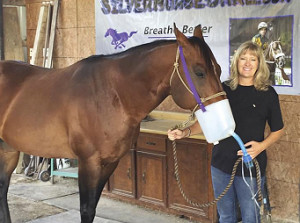Coughs & Causes – Why is My Horse Coughing?
Click here to read the complete article290 – July/August, 2017
by Heather Smith Thomas
 The sound of a horse coughing in the barn is unpleasant and worrisome. Even more disconcerting is a horse coughing while you are riding or showing him. Is this just irritation from a dusty arena, or a sign of disease? Most horse owners become “tuned in” to various nuances of equine coughing and are quick to try to figure it out and make sure the horse isn’t coming down with a bad “bug” that might need medical attention.
The sound of a horse coughing in the barn is unpleasant and worrisome. Even more disconcerting is a horse coughing while you are riding or showing him. Is this just irritation from a dusty arena, or a sign of disease? Most horse owners become “tuned in” to various nuances of equine coughing and are quick to try to figure it out and make sure the horse isn’t coming down with a bad “bug” that might need medical attention.
Horsemen have different ways of describing the horse’s cough— whether it is dry and unproductive, wracking, or moist and productive, bringing up mucus. If the horse is coughing, what are the reasons—and how can you come to some conclusions as to why that horse is coughing (such as dusty hay)? If there’s a chance it could be an infection you should get your veterinarian involved.
WHY DO HORSES COUGH?
Virginia Buechner-Maxwell, DVM, MS, Diplomate ACVIM, Professor of Large Animal Internal Medicine, Virginia-Maryland Regional College of Veterinary Medicine (Blacksburg, Virginia) points out the fact that air is not sterile. “When we breathe, we bring in dust and debris, and sometimes a few pathogens. Normal, healthy airways and lungs have several mechanisms for getting rid of dust and other types of debris that are inhaled,” she says.
A lot of the debris is caught in the trachea (windpipe) before it gets any farther, and moved back up to the throat, but even in the lower airways and lung tissue there are defenses for getting rid of foreign particles/pathogens—making sure these don’t create a problem. In the trachea, and throughout the airways, the lining has thousands of tiny hair-like projections called cilia.
“These tiny ‘hairs’ sit on top of the cells that line the trachea and bronchial tree of the lung. They create a continuous ‘shag carpet’ that covers and protects those airways. A thin sheet of clear mucus sits on top of these hairs and traps most of the debris. The cilia move/beat in a coordinated, wave-like fashion—similar to the wave you might see fans do at a football stadium, only these hairlike cells never stop beating. This wave motion moves the mucus sheet upward, toward the top of the trachea to the throat, so it can be either coughed out or swallowed,” she explains.
“This process is called the mucociliary clearance mechanism, and in healthy animals and people it is a very effective way of eliminating the debris that comes in with the air we breathe. The nose and sinuses have similar methods for trapping and eliminating inhaled particles. If you’ve been handling dusty hay or working in a dusty place, or riding in a dusty arena, you can see evidence of this when you blow your nose,” says Maxwell. The moisture that comes out of the nose contains a lot of dirt.
Click here to read the complete article290 – July/August, 2017










